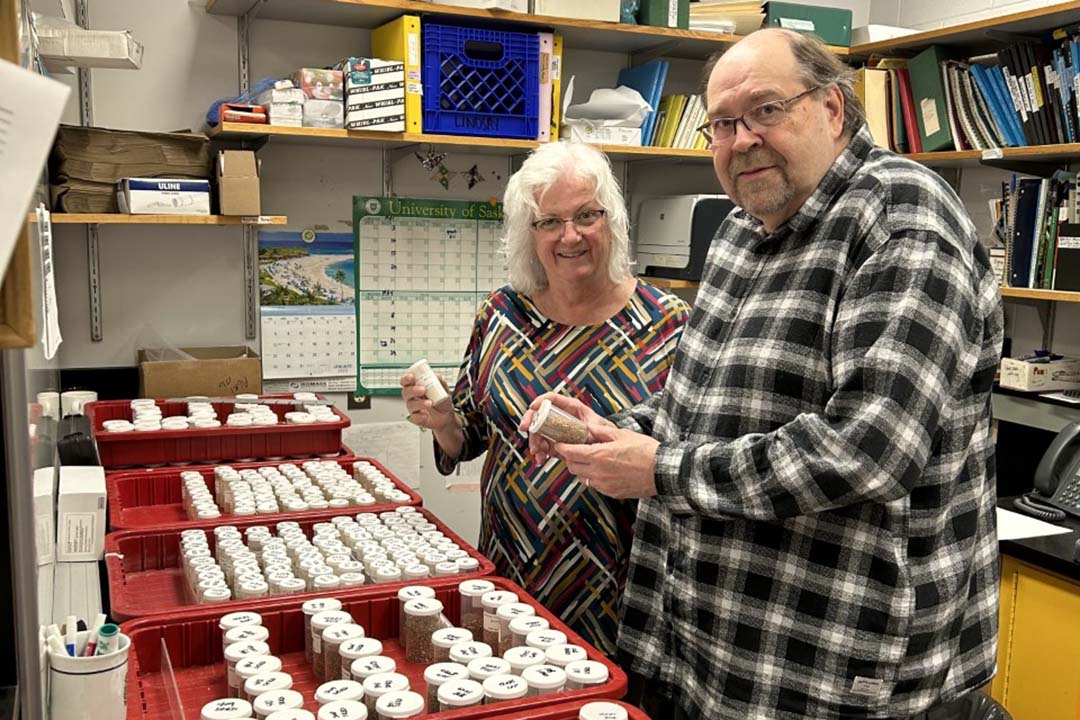
USask researchers develop new online nutrient calculator
As crop plans are mapped out for the 2023 growing season, there’s a new resource for farmers and agronomists to build a more complete picture of the nutrient requirements of key crops grown across Western Canada.
Two University of Saskatchewan (USask) soil scientists have just put the finishing touches on a new Prairie Nutrient Removal Calculator—an online tool that provides a critical piece of information to help make on-farm fertilizer decisions. It’s not a new concept, but the calculator is fueled by new, local data collected from commercial farms in Manitoba, Saskatchewan, and Alberta.
USask researchers Dr. Fran Walley (PhD) and Dr. Rich Farrell (PhD) led the three-year project that drew collaboration from numerous producer groups and industry. Many of the project funders were also very interested in having new information based on current farming practices.
“We know how valuable nutrient removal guidelines are, but the most recent guidelines available are from 2001,” said Walley, associate dean (academic) and professor in the College of Agriculture and Bioresources. “A lot has changed in the last few decades—different crops, genetics, management strategies and crop rotations—and so we set about to revise the existing guidelines to ensure the information was more relevant and reflective for today.”
The calculator provides nutrient removal rates for commonly grown Prairie crops.
Collecting new data is no small feat, especially during covid, but a truly collaborative approach made lighter work of the goal—to gather more than 2,200 grain and biomass samples representing 14 different crops.
“We really wanted to get a handle on what the nutrient uptake and removal was for commonly grown crops in commercial fields,” said Walley.
That’s where the value of collaboration really kicked in. To gather on-farm data, the research team enlisted agronomists in Saskatchewan and Alberta through Lyle Cowell of Nutrien Ag Solutions, field staff in Manitoba through John Heard with Manitoba Agriculture, field staff with the Saskatchewan Ministry of Agriculture, and researchers at Saskatchewan Agri ARM sites.
This army of on-the-ground collaborators enabled the team to collect the on-farm samples in 2020, 2021, and 2022. The researchers also credit post-doctoral fellow Gazali Issah for his work on this project.
To measure uptake—how much the crop takes up nutrients from the soil—plant tissue was collected at a growth stage when it was expected the plant was using the greatest amount of nutrients from the soil. Tissue was dried, crushed and analyzed for nitrogen, phosphorus, potassium and sulphur (macronutrients) as well as copper, boron and zinc (micronutrients).
For nutrient removal—how much is removed when the harvested grain leaves the field—seed samples were collected at harvest, along with information on crop yield, and analyzed for the same range of nutrients.
“This data helped us calculate the total amount of nutrients removed from the soil by the harvested crop,” said Farrell, associate professor in the College of Agriculture and Bioresources and the Ministry of Agriculture Strategic Research Program (SRP) Chair in Soil Biological Processes.
Both researchers admit that while nutrient uptake provides interesting information, it’s really nutrient removal—the level of each nutrient exported from the field in the grain—that’s a more accurate, easier number to determine. It’s the one that’s most valuable for producers and it’s the information that drives the new calculator.
With all the newly collected data in hand, the next step was using it to power the new online nutrient removal calculator.
“The calculator reflects the new data that was collected from 2020 to 2022 and provides a very sensible and conservative estimate of nutrient removal,” said Farrell.
What’s truly unique is that the Prairie Nutrient Removal Calculator runs on data from Western Canada.
“There are a lot of nutrient removal calculators available, but this one reflects the crop varieties and yield expectations in Western Canada,” said Walley.
Another unique aspect of this calculator is including micronutrients that are gaining more interest and monitoring for potential deficiency.
“Even though plants only use small amounts of copper, boron and zinc, they aren’t in the soil in large amounts, so it’s important to also measure their removal rates,” said Farrell.
The calculator focuses on nutrient removal as a more relevant number for farmers and agronomists than nutrient uptake. Users choose from the list of crops and add in known yield from the previous year or expected yield for the upcoming year, to find a nutrient removal value.
“We wanted the tool to be easy to use and be readily adaptable to be used on any device,” said Farrell.
The online calculator is now available at prairienutrientcalculator.info just in time for the 2023 season, and Walley and Farrell are confident that it will be a well-used resource as word about it gets out.
While the calculator provides relevant and reliable new information when it comes to managing crop inputs, Walley never misses an opportunity to reinforce the importance of soil testing. She cautions that the new calculator does not replace soil testing but provides another piece of information when making decisions about fertilizer management.
“The calculator can help you work through soil test reports and make nutrient adjustments as part of overall fertilizer management,” said Walley.
For Farrell, a great offshoot of the project was the incredible co-operation between all the participants.
“People embraced this project and were happy to participate, and it really showed what can happen with collaboration from the farming, research, and extension community,” said Farrell.
Funding for this project was provided by the Western Grains Research Foundation, Alberta Wheat Commission, Prairie Oat Growers Association, Saskatchewan Canola Development Commission, Saskatchewan Flax Development Commission, Saskatchewan Wheat Development Commission, with logistical support provided by Nutrien Ag Solutions, and Manitoba Agriculture and Resource Development.
Together, we will undertake the research the world needs. We invite you to join by supporting critical research at USask.

